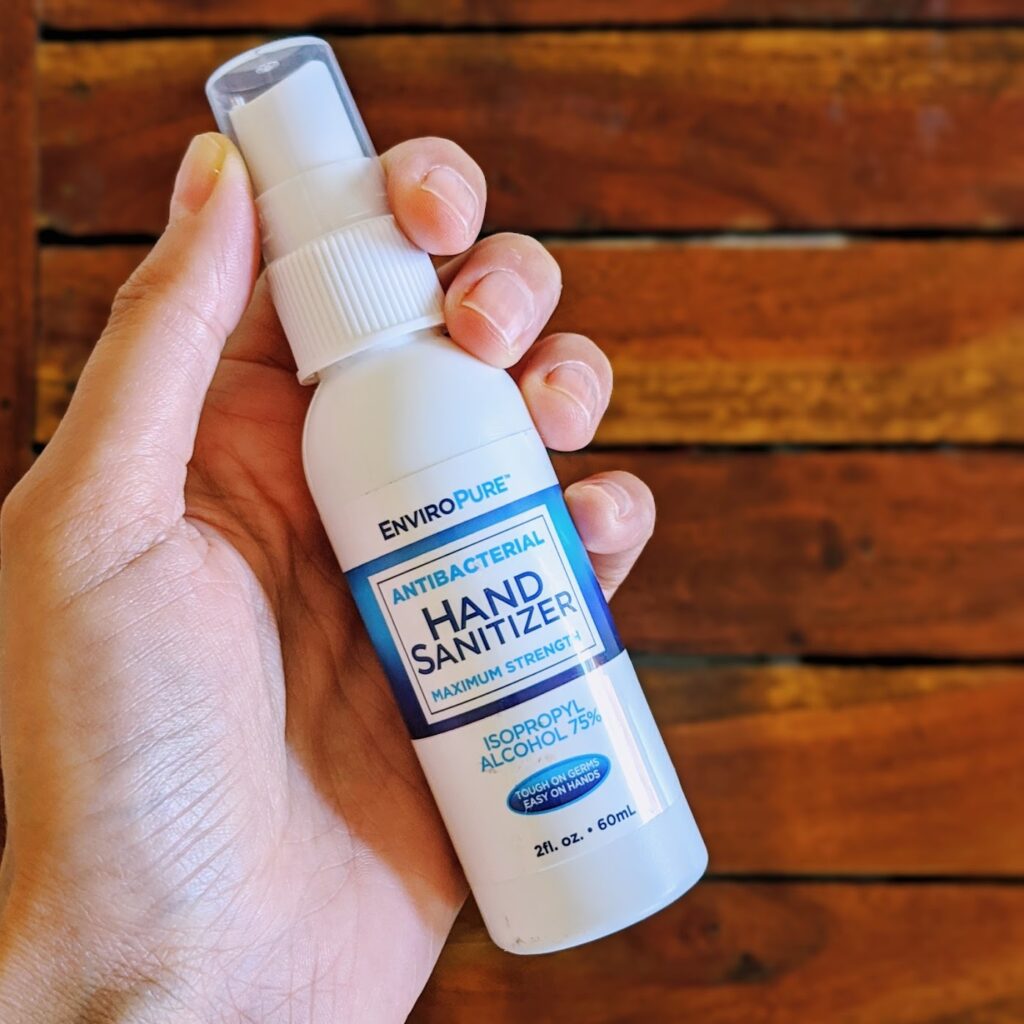What’s in Your Hand Sanitizer?
In recent news, the FDA has released an urgent report that many brands of hand sanitizers now on the market, are actually unsafe for use. I hope to answer some questions in a way that makes sense to consumers like you and me.

What is toxic about our hand sanitizers?
The main ingredients found in hand sanitizers are isopropyl alcohol and ethyl alcohol (also known as ethanol). These ingredients are what hand sanitizers are known for: killing germs and bacteria that might be on one’s hands or other surfaces. However, there are some toxic ingredients that you won’t find on the label, such as methanol.
So where does methanol come into play?
Methanol is a natural byproduct that arises during the alcohol distillation process, and the manufacturer must remove the majority of it according to FDA guidelines before packaging and selling a product containing this dangerous substance. Why are we just now hearing about this? Well, since the coronavirus pandemic, countless companies have arisen seemingly out of nowhere to capitalize on the hand sanitizer craze. The reason for the sudden rise in toxic hand sanitizers is due, most likely, to “sloppy manufacturing processes” where these newer companies are either 1) not properly removing the methanol during distillation from the ethyl alcohol, or 2) they are violating FDA regulations by starting with an “already distilled high-methanol solvent as their base” (Lanese, 2020). What’s worse- methanol is not actually listed on the ingredients list on the bottle. Major. Bummer.
What are considered dangerous levels of methanol? Where did companies go wrong?
According to Live Science, methanol can be lethal at fairly low doses. Ingestion of as little as 2 tablespoons (30 milliliters) of methanol can be deadly for a child, and 2 to 8 ounces (60 to 240 milliliters) can be deadly for an adult. Topically, methanol can be “particularly dangerous for children, who have a greater ratio of skin surface area to body weight as compared with adults… Consumers would likely need to apply the product repeatedly (as one does with hand sanitizer) to absorb a dose high enough to become poisoned” (Lanese, 2020).
To be fair, small amounts of methanol are found in distilled alcoholic beverages, such as methyl alcohol in brandy. But it’s important to know that this is very regulated, which the FDA caps a maximum permitted level of 0.35%. So basically, while commercial producers of alcohol make sure to abide by important safety rules, many unregulated moonshine makers (often from foreign countries) have forsaken these guidelines.
What are the health risks associated with methanol?
According to the FDA, substantial methanol exposure can result in:
- Nausea
- Vomiting
- Headache
- Blurred vision
- Permanent blindness
- Seizures
- Coma
- Permanent damage to the nervous system or death (FDA, 2020).
How does methanol work in your body?
For those of you who enjoy more scientific understanding of what’s going on in the body when ingested/absorbed, methanol turns into formaldehyde and other metabolites in your liver as it breaks down. This formaldehyde then gets passed to another enzyme that transforms it into formic acid. The formic acid then spikes the pH of the blood and makes it dangerously acidic. This acidity causes a number of problems such a disrupting the cells ability to produce energy, building up waste in the blood, and permanently damaging nerve cells and even retina and optic nerve cells, as seen in a 2011 report by The Indian Journal of Ophthalmology. In other words, within four to six hours of ingestion/absorption, high levels of methanol can manifest symptoms in the body and bring your blood pH up to permanently damaging levels (Lanese, 2020).
How can I tell if my hand sanitizer has methanol in it?
Unfortunately, while experts can smell the difference between methanol and ethanol (because it has a more “chemical” smell to it), most consumers can’t. Second, it’s not listed on the bottle. Third, we are left with basically needing to check the FDA’s list of recalled sanitizers as well as avoid unknown brands of sanitizer. So really, we’re kind of left in the dark here.
Can I make my own?
While this would make everything much more convenient, the FDA recommends that it is not a good idea to try making your own hand sanitizers at home. The main reason? Homemade sanitizers can either be 1) ineffective or 2) cause skin burns for some. For more specific answers from the FDA on important questions surrounding hand sanitizers, view this page.
That being said, there are a few people who are advocating for making your own out of isopropyl alcohol and essential oils. Even in the same article, however, Vanessa Thomas, a cosmetic chemist and CEO of Freelance Formulations, recommends against making your own sanitizers due to unsterile conditions, contamination, potential for fires caused by alcohol, and the harshness of unregulated alcohol on human skin.
What are some good brands I can use?
It is important to remember that not all companies that use ethanol/ethyl alcohol are bad. The brands listed below are from reputable companies I still recommend due to their reputations as clean companies with few additional toxins.
(Prices are due to multi-packs)
Sanitizers made with Isopropyl Alcohol and/or are extremely clean in other ingredients:
Hand Sanitizer Companies to Avoid due to Methanol
- 4E Global
- AAA Cosmetica
- DDI Multinacional
- Eskbiochem
- Grupo Insoma
- ITECH 361
- Liqesa Exportacion (Liq-E-S.A)
- Limpo Quimicos
- Maquiladora Miniara
- MXL Comercial
- Mystic International
- Real Clean Distribuciones
- Saniderm Products
- Soluciones Cosmetica
- Transliquid Technologies LLC
- Tropicosmeticos
(Capritto, 2020)
Additional FDA banned list provides a searchable list of hand sanitizers that have been recalled.
Other Toxic Substances in Hand Sanitizers to Avoid
Methanol isn’t the only harmful ingredient in sanitizer. I’ll provide a quick rundown, but you can see more information on Clear and Well and other reputable websites.
- Synthetic fragrances (over 3,000 of these exist. they disrupt your endocrine system and hormones in the body)
- Parabens (they can mimic estrogen and are associated with breast cancer formation)
- Petroleum products (propylene glycol, PEG, PAHs and petrolatum)
- Triethanolamine (an allergen and possible toxicant for the immune system)
- Ammonia (toxic to humans and can accumulate in the body)
- many more…
Companies like the Environmental Working Group have a great “clean” scale to compare various products and the toxicity/cleanness of each of the ingredients on the product label.
All in all, it is important to be your own advocate and researcher. I haven’t even gotten into why over-sanitizing can be doing more harm than good, an important topic to cover for another day. Nonetheless, please consider what will be best for you and your family by consciously choosing products that will be safe and promote health and wellness.
This post contains affiliate links, which means that as an Amazon associate, I make a small commission at no extra cost to you if you choose to make a qualifying purchase.
For more information on what guidelines companies must abide by, see these formulas or hand sanitizer provided by the World Health Organization (WHO) and the FDA. They must be made of 96% ethanol alcohol by volume (ABV), hydrogen peroxide diluted to 3% of its maximum concentration, and glycerol diluted to 98%. Recipes between isopropyl alcohol and ethanol will vary in ratio.
Resources
Capritto, Amanda (2020, July 28). FDA hand sanitizer warnings: Toxic ingredient found in these brands.
Clear and Well (2017, Aug 4). How to Choose Safe Hand Sanitizer + 18 Brands to Avoid Retrieved from https://clearandwell.com/safe-hand-sanitizer-brands-to-avoid/
FDA (2020, July 27). FDA Updates on Hand Sanitizers with Methanol. Retrieved from https://www.fda.gov/drugs/drug-safety-and-availability/fda-updates-hand-sanitizers-methanol
FDA (2020, July 29). Q&A for Consumers: Hand Sanitizers and COVID-19. Retrieved from https://www.fda.gov/drugs/information-drug-class/qa-consumers-hand-sanitizers-and-covid-19
Lanese, Nicoletta (2020, July 28).Dozens of hand sanitizers contain a toxic ingredient. How do you know yours is safe? Retrieved fromhttps://www.livescience.com/methanol-tainted-hand-sanitizer-safety.html






